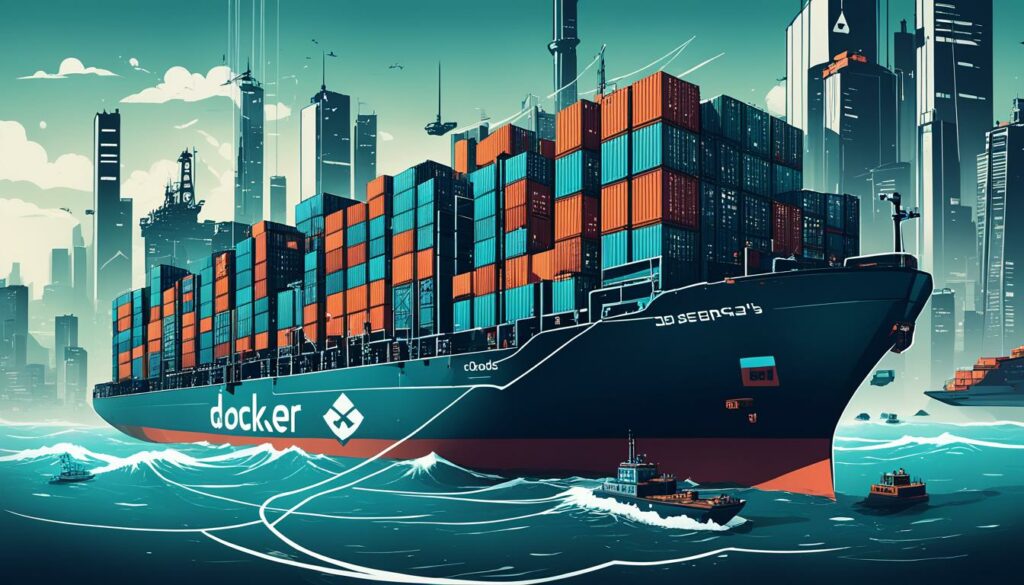Node.js is a powerful tool for application development, offering scalability, flexibility, and high performance capabilities. If you’re planning to deploy your Node.js application, it’s essential to have effective deployment strategies in place. In this guide, we will explore tips and techniques for deploying Node.js applications, ensuring a seamless and efficient deployment process.
Key Takeaways:
- Choose the right deployment strategy for your Node.js application, considering factors such as scalability, portability, and ease of management.
- Consider using process managers like PM2, containerization with Docker, or platform as a service (PaaS) options like Heroku for efficient deployment.
- Update dependencies regularly and implement proper error handling to ensure the stability and security of your deployed Node.js application.
- Set up environment variables and optimize performance to enhance the scalability and responsiveness of your Node.js app.
- Monitor the performance of your deployed application and make necessary optimizations to guarantee a successful deployment.
Understanding Node.js Deployment
Node.js is an open-source, cross-platform JavaScript runtime environment used to build server-side applications. It utilizes an event-driven architecture and a nonblocking I/O model, making it lightweight and efficient for real-time applications.
When deploying Node.js applications, there are various techniques and options available to ensure scalable and reliable deployments in production environments. Let’s explore some of these Node.js deployment techniques and options:
- Process Managers: Process managers like PM2 provide features for managing and monitoring Node.js applications in production environments. They allow you to easily scale your app across multiple instances, handle application crashes, and achieve high availability.
- Containerization: Containerization platforms like Docker enable you to package your Node.js application and its dependencies into lightweight, isolated containers. This ensures consistent deployments and makes it easier to manage dependencies, configurations, and scaling aspects.
- Serverless Platforms: Serverless platforms, such as AWS Lambda, offer a way to deploy Node.js applications without managing servers or infrastructure. With serverless, you can focus on writing your application code and let the platform handle scaling and resource allocation.
- Platform as a Service (PaaS): PaaS options like Heroku and Railway provide a managed environment for deploying and hosting Node.js applications. They handle infrastructure management, deployment workflows, and scaling, allowing developers to focus on application development.
Node.js Deployment Techniques
“When it comes to deploying Node.js applications, you have various techniques and options at your disposal. Consider your specific requirements and choose the deployment approach that best suits your needs.”
Each of these deployment techniques has its advantages and use cases. Process managers offer control and scalability, containerization provides consistency and portability, serverless platforms reduce operational overhead, and PaaS options streamline the deployment process.
Node.js Deployment Options
| Technique | Advantages | Use Cases |
|---|---|---|
| Process Managers (e.g., PM2) |
|
|
| Containerization (e.g., Docker) |
|
|
| Serverless Platforms (e.g., AWS Lambda) |
|
|
| Platform as a Service (PaaS) |
|
|
Understanding these Node.js deployment techniques and options will help you make informed decisions when deploying your Node.js applications in production. Consider your application’s requirements and choose the approach that aligns with your scalability, availability, and management needs.
Deploying Node.js with PM2
When it comes to deploying Node.js applications, one powerful tool that stands out is PM2, the Node.js process manager. PM2 offers a range of features that make deploying and managing Node.js apps a breeze. With its real-time monitoring and management capabilities, support for multiple instances, hot reloading, and logging management, PM2 provides a robust and efficient solution for deploying your Node.js applications.
One of the main advantages of using PM2 is its ease of use. With just a few simple commands, you can launch and manage your Node.js app on the cloud without the need for extensive manual configuration. PM2 handles the process management, ensuring that your application runs smoothly and efficiently.
Real-time monitoring is a key feature of PM2. It allows you to keep track of your application’s performance and resource usage, providing valuable insights into potential bottlenecks and areas for optimization. With PM2’s monitoring capabilities, you can quickly identify and resolve issues, ensuring that your app delivers optimal performance.
Another useful feature of PM2 is its support for multiple instances. This allows you to scale your Node.js application horizontally by running multiple instances of your app simultaneously. By distributing the workload across multiple instances, you can handle higher traffic volumes and improve the overall performance and reliability of your application.
PM2 also supports hot reloading, which means you can update your Node.js app without having to restart the entire application. This feature is particularly useful for applications that need to be continuously available, as it minimizes downtime and disruption to user experience. With hot reloading, you can make code changes on the fly, improving development efficiency and reducing deployment friction.
Additionally, PM2 provides robust logging management. It allows you to easily view and analyze application logs, helping you debug issues, track errors, and gain valuable insights into your app’s behavior. PM2’s logging capabilities make it easier to monitor and troubleshoot your application, ensuring that any issues are promptly identified and resolved.
“PM2 is a powerful process manager for Node.js applications. It simplifies the deployment process and provides valuable features like real-time monitoring, multiple instance support, hot reloading, and logging management. With PM2, you can deploy and manage your Node.js app with ease.”
Whether you are a developer looking to deploy your Node.js application on the cloud or an organization looking for an efficient and reliable solution for managing your Node.js apps, PM2 is a must-have tool. Its rich feature set and user-friendly interface make it a popular choice among developers worldwide.
To give you a better idea of how PM2 can enhance your Node.js deployment experience, here is a table highlighting some of its key features:
| Feature | Description |
|---|---|
| Real-time monitoring | Monitor application performance and resource usage in real-time |
| Multiple instance support | Scale your application horizontally by running multiple instances |
| Hot reloading | Update your application on the fly without restarting the entire app |
| Logging management | View and analyze application logs to track errors and debug issues |

As you can see, PM2 offers a comprehensive set of features that streamline the deployment process and enhance your Node.js application’s performance and reliability. By deploying your Node.js app with PM2, you can ensure seamless deployment and efficient management of your applications.
Deploying Node.js with Docker
Docker is a popular containerization platform that revolutionizes the way you deploy Node.js applications. With Docker’s containerization technology, you can package your Node.js apps into self-contained and lightweight units called containers.
Why is containerization important for deploying Node.js apps? Well, containerization with Docker offers several key benefits:
- Consistency: Docker ensures that your app runs consistently across different environments. You won’t encounter the dreaded “It works on my machine” issue anymore.
- Portability: Docker allows you to run your Node.js app on any platform without worrying about compatibility. It eliminates the need for time-consuming configuration and setup.
- Scalability: Docker containers provide a scalable deployment option. You can easily create multiple instances of your app to handle increased load and traffic.
- Efficiency: Docker’s lightweight containers consume fewer resources compared to traditional virtual machines. This means faster deployment times and improved performance.
Deploying your Node.js app with Docker is a straightforward process. Here are the basic steps:
- First, you’ll need to create a
Dockerfilethat defines the configuration and dependencies for your Node.js app. - Next, you’ll build a Docker image using the
docker buildcommand. This image contains everything needed to run your app. - Once the image is built, you can create a container using the image with the
docker runcommand. - Your Node.js app is now running in a Docker container! You can access it through a specified port and test its functionality.
By deploying your Node.js app with Docker, you can streamline your development process, improve collaboration, and ensure consistent deployment across different environments.
“Docker containers provide developers with a powerful tool for deploying Node.js applications. They offer the flexibility, scalability, and reliability needed for modern software development.”
So, if you’re looking for a reliable and scalable deployment option for your Node.js app, Docker containers are the way to go. Their portability and consistency make them an ideal choice for deploying Node.js applications on any platform or infrastructure.
Now that you understand the benefits of deploying Node.js with Docker, let’s take a closer look at another popular deployment option: Heroku.
Comparing Node.js Deployment Options
| Deployment Option | Key Features |
|---|---|
| Docker | – Consistency – Portability – Scalability – Efficiency |
| Heroku | – Simplified deployment – Autoscaling – Logging management |
| PM2 | – Real-time monitoring – Hot reloading – Logging management – Support for multiple instances |
As you can see from the table, each deployment option offers unique features and benefits. Choose the option that best suits your specific needs and requirements.

Deploying Node.js with Heroku
When it comes to deploying Node.js applications, Heroku is a convenient and popular platform as a service (PaaS) provider. With Heroku, developers can simplify the deployment process and focus on building their applications without worrying about managing servers or infrastructure.
Heroku offers a range of features that make it an attractive choice for deploying Node.js apps. One of its key features is autoscaling, which allows your application to automatically adjust its resources based on demand. This ensures that your app can handle traffic spikes without any issues.
“With Heroku’s autoscaling feature, your Node.js apps can handle any amount of traffic, ensuring a seamless user experience.”
Another useful feature provided by Heroku is logging. The platform offers built-in logging capabilities that allow you to monitor your application’s performance and troubleshoot any issues that may occur. You can easily access and analyze log data, helping you identify and resolve problems promptly.
In addition to autoscaling and logging, Heroku offers seamless integration with popular tools and frameworks used in the Node.js ecosystem. It supports various development workflows, including Git integration for easy deployment and Continuous Integration and Continuous Deployment (CI/CD) pipelines.
Heroku also provides extensive documentation and a user-friendly interface, making it easy for developers to get started with deploying Node.js apps. The platform offers a free tier and flexible pricing plans, allowing you to choose the option that best suits your needs and budget.
Overall, Heroku’s platform as a service (PaaS) features and user-friendly interface make it an excellent choice for deploying Node.js applications. Whether you’re a beginner or an experienced developer, Heroku simplifies the deployment process and provides the necessary tools to ensure your app runs smoothly.

Table: Feature Comparison: Heroku vs. Other Node.js Deployment Platforms
| Heroku | Platform X | Platform Y | |
|---|---|---|---|
| Autoscaling | Yes | No | No |
| Logging | Yes | Partial | Yes |
| Git Integration | Yes | Partial | No |
| Documentation | Extensive | Limited | Limited |
Best Practices for Node.js Deployment
When deploying Node.js applications, it’s crucial to follow the best practices to ensure a smooth and successful deployment. By implementing these practices, you can optimize the performance, scalability, and responsiveness of your Node.js apps. Here are some tips for deploying Node.js apps:
1. Update dependencies
Regularly updating your dependencies is essential to ensure compatibility and security. Keep track of the latest versions of your libraries, frameworks, and packages, and update them accordingly. This helps you leverage new features, bug fixes, and performance improvements.
2. Implement proper error handling
Error handling is vital to handle unexpected issues and prevent application crashes. Set up error monitoring and logging tools to capture and track errors in real-time. Use try-catch blocks and apply appropriate error handling techniques, such as returning meaningful error messages to users and logging errors for debugging purposes.
3. Set up environment variables
Utilize environment variables to store sensitive information, configuration settings, and API keys. This practice helps separate the application’s configuration from its codebase, allowing for easier deployment and maintenance across different environments. Consider using tools like dotenv to manage environment variables effectively.
4. Automate the deployment process
Streamline the deployment process by automating repetitive tasks. Use continuous integration and continuous deployment (CI/CD) pipelines to automate building, testing, and deploying your Node.js app. This ensures consistency and reduces the risk of human error during deployment.
5. Monitor application performance
Monitor your Node.js app’s performance in real-time to identify bottlenecks, inefficient code, or resource-intensive operations. Utilize tools like the Node.js built-in performance hooks or third-party monitoring solutions to gain insights into CPU usage, memory consumption, event loop delays, and other critical metrics.
6. Optimize app performance for scalability and responsiveness
Optimize your Node.js app for scalability and responsiveness to handle increased traffic and user load. Utilize techniques like caching, load balancing, and clustering to distribute the workload efficiently. Identify areas where you can refactor code or optimize algorithms to improve performance.
“By following these best practices, you can deploy your Node.js applications with confidence, ensuring their stability, security, and optimal performance.”
To summarize, deploying Node.js applications involves more than just deploying code. Following the best practices for Node.js deployment, such as updating dependencies, implementing proper error handling, setting up environment variables, automating the deployment process, monitoring application performance, and optimizing app performance, can greatly enhance your deployment experience and ensure the success of your Node.js apps.
Conclusion
Deploying Node.js applications requires careful planning and consideration of hosting platforms, deployment strategies, and best practices. By following effective deployment strategies and employing best practices, you can ensure your Node.js apps are deployed smoothly, efficiently, and securely.
Consider different options like PM2, Docker, and Heroku based on your specific needs and requirements. PM2 is a production process manager specifically designed for Node.js applications, offering real-time monitoring, multiple instance support, hot reloading, and logging management. Docker allows you to package your Node.js app into self-contained environments called containers, providing consistency and portability across different platforms. Heroku, on the other hand, is a convenient platform as a service (PaaS) option that simplifies the deployment process for Node.js apps, offering features like autoscaling and logging.
Implementing proper error handling, setting up environment variables, and optimizing performance are crucial for a successful deployment. Proper error handling ensures that your app gracefully handles failures and prevents crashes. Setting up environment variables helps you store sensitive information securely, such as API keys and database credentials. Optimizing performance improves scalability and responsiveness, allowing your app to handle high traffic loads effectively.
With these strategies and practices in place, you can confidently deploy your Node.js applications and ensure their success in a production environment. Remember to stay up-to-date with the latest Node.js trends and continue learning to enhance your deployment skills. Good luck!
FAQ
Q: What are some effective deployment strategies for Node.js applications?
A: Some effective deployment strategies for Node.js applications include using process managers like PM2, containerization with Docker, serverless platforms like AWS Lambda, and platform as a service (PaaS) options like Heroku and Railway.
Q: What is PM2 and how can it help with deploying Node.js applications?
A: PM2 is a production process manager designed specifically for Node.js applications. It offers real-time monitoring, support for multiple instances, hot reloading, and logging management. PM2 provides an easy and efficient way to launch and deploy Node.js apps on the cloud without extensive manual configuration or maintenance.
Q: What is Docker and how can it be used for deploying Node.js applications?
A: Docker is a containerization platform that allows developers to package their applications into self-contained environments called containers. Deploying Node.js apps with Docker ensures consistency and portability across different platforms. Docker containers provide a reliable and scalable deployment option for Node.js applications, allowing developers to easily deploy their apps on any platform with minimal configuration.
Q: How can Heroku simplify the deployment process for Node.js apps?
A: Heroku is a popular platform as a service (PaaS) provider that simplifies the deployment process for Node.js apps. With Heroku, developers don’t need to worry about managing servers or infrastructure. It offers features such as autoscaling and logging, making it a convenient option for deploying Node.js applications without the need for extensive server management.
Q: What are some best practices for deploying Node.js applications?
A: Some best practices for deploying Node.js applications include updating dependencies, implementing proper error handling, setting up environment variables, automating the deployment process, monitoring application performance, and optimizing app performance for scalability and responsiveness.












